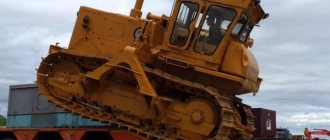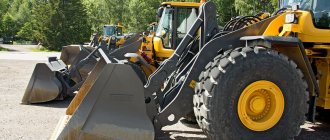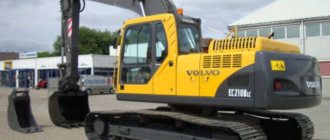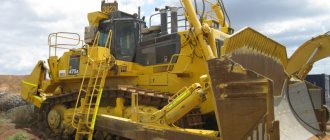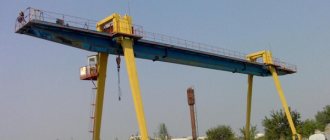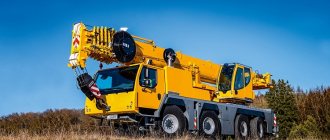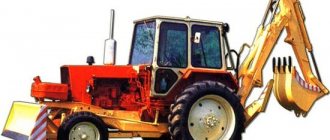Since pipelayers usually work in remote areas with harsh conditions, reliability and reliability, i.e. high utilization rates, are very important to them, since machine failure during intense construction work can result in huge losses in time and money. It is no coincidence that builders all over the world generally prefer pipelayers from brands such as Caterpillar, Komatsu, and Liebherr, which are reliable and have good service support from a wide dealer network. In addition to domestic factories, the same Western manufacturers are popular on the Russian market.
In recent years, Chinese companies Shantui, LiuGong, XCMG, PengPu and others have entered the markets of Africa, Asia and Eastern Europe with similar equipment.
More than 50% of domestic pipelayers produced in recent years belong to the class of lifting capacity 26–27 tons. Therefore, in the total volume of pipelayers imported into the country, the main share (up to 70–80%) is made up of machines of heavier classes with a load capacity of 90–92 tons.
Secondary market
Pipelayers are characterized by long service life. On the secondary market, there are often examples of sales of cars that are 30–40 years old and even older, and at good prices. As a rule, this is Caterpillar and to a lesser extent Komatsu. For example, in 2013, Cat D7 pipelayers manufactured in 1947 were sold for $8,000, and those made in 1946 were sold for $8,000. – for $5500. Such prices indicate that despite their advanced age, these machines are still capable of working on pipeline laying and bringing good profits to their owners.
It should be noted that despite their advanced age, the operating hours of many pipelayers are not that high compared to other earthmoving machines. In addition, during operation they only slowly move along the pipeline trench, and therefore their chassis wears out relatively little.
Machines designed for laying pipes with a diameter of up to 36 inches (914 mm) have gained wide popularity, since many pipelines fall into this category, including oil pipelines, as well as inlet and outlet pipes from oil refineries and other similar enterprises. Such pipelines are in wide demand in countries where the productivity of fields is not the highest.
In general, there is a trend in the world of increasing pipeline diameters. Therefore, in the secondary market, the “focus of popularity” is shifting to models with higher load capacity.
A buyer choosing a used car is recommended first of all to pay attention to the condition of the winch, as well as friction clutches, which, however, like the undercarriage track shoes, usually have a long service life.
Crawler pipe-laying cranesRussian market overview
Recently, the Government of the Russian Federation has made a number of decisions that determined the program for the development of the country's pipeline network for the period until 2010. The increase in the length of gas pipeline networks by 2010 should be 75...80 thousand km. Major interstate agreements on pipeline construction have been adopted. All this suggests that increased attention will be paid to ensuring the construction of pipelines with the necessary means of mechanization, including pipe layers.
The accident rate on Russian pipeline systems has recently increased. According to specialists from Stroytransgaz JSC, it amounts to up to two major accidents per year for every 1000 km of pipelines. Eliminating the consequences of accidents and carrying out preventive repairs of pipeline systems also require the use of pipe layers.
The production of domestic tracked pipe layers is concentrated mainly on two tractor plants (formerly Cheboksary Industrial Tractor Plant) and Chelyabinsk Tractor Plant-Uraltrak LLC. Pipe layers produced by Berezovsky Mechanical Repair Plant LLC are based on tractors supplied from the Chelyabinsk Tractor Plant, on which pipe-laying equipment is installed. Low-capacity pipelayers (LLC) were produced by OJSC Gazstroymash on separate orders with the necessary components, assemblies and transmission systems, chassis, superstructure and control systems supplied from tractor factories (Chelyabinsk and Volgograd).
Pipe-laying cranes are used in the construction of pipelines with a diameter of 200 to 1420 mm and are designed for loading and unloading pipes arriving for construction, holding them in a raised state during welding operations in the strands, accompanying cleaning and insulating equipment, transporting finished strands with their subsequent laying in trench. Pipe layers as lifting equipment are used when performing construction and installation work and when repairing pipeline systems. A feature of the operation of pipelayers as part of an insulation-laying column is the variable nature of the loads, depending on the mass and elasticity of the lifting string, the terrain, as well as the synchronization of the actions of operators of other pipelayers.
Pipelayers are classified according to their rated load capacity, type of running gear, and type of drive of lifting equipment. The main parameter is the pipelayer's lifting capacity. To date, in world practice, two concepts of lifting capacity are used in relation to pipe-laying cranes: “lift capacity” and “load capacity”. The concept of “lift capacity” according to the SAE 743B standard is interpreted as the amount of load on the hook that the pipelayer lifts at a given reach, but at the same time, none of the support rollers of the undercarriage system on the side opposite the boom should be lifted from the caterpillar tread by more than 6 mm (0.25 inch). Currently, according to the ISO 8813 standard, this concept is interpreted as the maximum load capacity at a specific radius. Typically, the cargo characteristics according to this standard are given in technical materials.
The term “load capacity” according to the ANSI/ASME B30.14 standard indicates a load value that is 85% of the maximum load capacity for tracked pipelayers. This standard allows for its reduction in some areas of the load characteristics if safety is limited not by the machine overturning, but by the strength of the structural elements. The same standard defines the approach to establishing the operating range of the load characteristics.
In our country, when classifying by nominal lifting capacity, the maximum permissible load on the pipelayer hook when working with single loads is taken as the basis. GOST 15150 provided for five standard sizes of pipe layers with a nominal capacity of 6.3; 12.5; 20; 32 and 50 t.
In Russia, the development of pipe layers was carried out in two directions:
- for pipelayers with a lifting capacity of 12 tons and more, specialized pipelaying modifications or special tractor configurations were created as base machines;
- For pipelayers with a lifting capacity of 6.3 tons, a tractor transmission of traction class 3 and a chassis system of a tractor of traction class 10 were used.
To determine the levels of lifting capacity of pipe-laying equipment, two values of the reach of lifting pipe-laying equipment are adopted in domestic practice. To determine the maximum load capacity, the reach is taken to be 1.2...1.25 m (average 1.22 m), and to determine the nominal load capacity in a given operating range, the reach is taken to be 2.5 m.
In world practice, the following gradation of pipe layers has developed depending on the level of their nominal load capacity in the working area. This gradation is divided into three categories: light, medium and heavy. The light category includes pipelayers with a capacity of up to 12.5 tons, the medium category with a capacity of over 12.5 to 30 tons, and the heavy category with a capacity of over 30 tons.
The domestic industry has mastered the production of pipe layers in all categories of lifting capacity. OJSC Gazstroymash and the Kropotkin Machine-Building Plant, on separate orders, produce light-category tracked pipe layers with a stability moment of 16 kN m and a nominal lifting capacity of 6.3 tons, models TG-61 and TG-62.
ChTZ-Uraltrak LLC produces pipelayers of two levels with a lifting capacity of 12.5 and 20 tons with booms 7 and 9 m long, with a folding and non-folding counterweight block based on a special modification (complete set) of an industrial swamp tractor of traction class 10 (Table . 1).
Table 1. Technical characteristics of pipe layers produced by ChTZ-Uraltrak LLC
| Parameter | TR 12.21.01/02 | TR 20.21.01/02 | TR 12.27.06 | TR 20.27.06 |
| Load capacity max., t (reach 1.22 m) | 27 | 41 | 27 | 41 |
| Nominal load capacity, t (reach 2.5 m) | 12,5 | 20 | 12,5 | 20 |
| Load stability moment, tf m | 35 | 50 | 33 | 50 |
| Engine power, kW (hp) | 132 (180) | 132 (180) | 139 (190) | 139 (190) |
| Operating weight, t, no more | 28,8 | 31 | 26,55 | 30,23 |
| Boom length, m | 7 and 9 | 7 and 9 | 9 | 9 |
| Max. hook lifting height, m | 5.7 and 7.7 | 5.6 and 7.6 | 7,9 | 7,7 |
| Hook lowering depth at min. boom radius, m | 2,5 | 2,5 | 2,5 | 2,5 |
| Average static specific pressure on the ground of the left track, MPa | 0,2 | 0,25 | 0,18 | 0,24 |
| Counterweight type | Non-reclining | Reclining | Non-reclining | Reclining |
| Winch type | Double-drum reversible with multi-disc friction clutches, hydraulically controlled | Single drum with hydrostatic drive and planetary gearbox | ||
The main difference between the TR 12.27.06 and TR 20.27.06 pipelayers and the TR 12.21.01 and TR 20.21.01 models is the smooth and stepless change in the lifting speeds of the hook and boom (in a wide range), which reduces the dynamics of loading and increases the accuracy of installation of pipeline strings . This was achieved through the use of winches LG-35 (LG-55) with a hydrostatic adjustable drive.
Berezovsky Mechanical Repair Plant LLC, based on ChTZ tractors, produces five models of tracked pipelayers (Table 2), one of which, TB-4, has an outrigger mounted on the opposite side of the trench, which increases the pipelayer’s load-carrying capacity.
Table 2. Technical characteristics of pipe layers produced by Berezovsky Mechanical Repair Plant LLC
| Parameter | OMT-16 | TB-3 | TBG-20.01 | TBG-20.01.9 | TB-4 |
| Nominal load capacity, t | 16 | 16 | 20 | 20 | 16/ 40* |
| Load stability moment, tm | 34 | 42,6 | 48 | 48 | 48,9** |
| Basic tractor | T-10.1111 | T-10B0121-2 | |||
| Engine power, kW/l. With. | 125 (170) | 132 (180) | 132 (180) | 132 (180) | 132 (180) |
| Operating weight, t | 21,8 | 25,3 | 27 | 27 | 27,5 |
| Boom length, m | 6 | 7 | 7 or 9 | 9 | 7 |
| Boom radius max./min., m | 6,0/ 1,5 | 6,9/ 1,8 | 7 or 8.7/ 1.8 or 2.1 | 8,7/ 2,0 | 6,9/ 1,8 |
| Hook lifting height max., m | 5 | 6,17 | 6 or 8 | 8 | 6,17 |
| Track width, mm | 480 | 920 | 920 | 920 | 920 |
| Average static specific pressure on the ground at rated load capacity, MPa | 0,29 | 0,13 | 0,15 | 0,15 | 0,143*** |
| Load lifting and lowering speed, m/min | 0,6…7,2 | 0,6…7,2 | 0,47…17,0 | 0,47…17,0 | 0,6…5,7 |
*In the numerator – without an outrigger, in the denominator – with an outrigger. **Without outrigger. ***With a load of 40 tons.
OJSC Ochersky Machine-Building Plant can produce a limited volume of the TG-126 pipelayer based on a tractor of traction class 10 on individual orders. The load moment of stability is 30 tfm. The nominal lifting capacity is 12.5 tons. In addition to the main boom, the pipelayer can be equipped with a jib extension, allowing for loading, unloading and installation operations.
Promtractor OJSC has achieved significant achievements in the field of tracked pipe layers.
The company has developed designs and organized mass production of pipe layers of four levels of lifting capacity in all categories, from light to heavy (Table 3). This standard range of pipelayers covers the range of nominal lifting capacity from 12.5 to 50 tons. The entire family of pipelayers is based on special modifications of the basic models of crawler tractors of traction classes 11, 15, 20, 35 and 40, which have a developed chassis system with an increased supporting surface and an increased number of road wheels, with a rigid suspension with a transverse beam. All models are equipped with a hydromechanical transmission with planetary gearboxes, providing three forward and reverse gears. Pipelayers are also equipped with double-drum winches with planetary gearboxes with hydrostatic drive. The boom and lifting and lowering of the load are controlled by rope-block mechanisms, and the block is controlled by a counterweight using a hydraulic drive. Table 3. Technical characteristics of pipe layers produced by Promtractor OJSC
| Parameter | Chetra 121 | Chetra 221 | Chetra 301 | Chetra 503 | Chetra N 511 |
| Load capacity, t, at reach 2.5 m / 1.22 m | 12,5/ 25,6 | 21,0/ 44,2 | 31,0/ 63,5 | 50,0/ 102,0 | 51,0/ 104,5 |
| Engine power of the Yaroslavl Motor Plant, kW (hp) | 127 (173) | 170 (238) | 228 (310) | 298 (400) | – |
| Cummins engine power, kW (hp) | 131 (178) | 222 (302) | 222 (302) | 308 (413) | 350 (476) |
| Operating weight, t | 22,5 | 32,5 | 44 | 69 | 64 |
| Number of track/support rollers on each side | 08.02.09 | 08.02.09 | 08.02.09 | 09.02.09 | 08.02.09 |
| Track width, mm | 560 | 610 | 710 | 860 | 800 right, 1000 left |
| Average static specific pressure on the ground without load on the hook, kgf/sq.cm | 0,66 | 0,86 | 0,88 | 0,94 | 0,86…0,88 |
| Transmission type | Hydromechanical | ||||
| Forward speed, km/h | 3,7…10,8 | 3,8…9,8 | 3,8…10,0 | 4,3…12,6 | 4,2…12,7 |
| Reverse speed, km/h | 4,9…13,9 | 4,9…11,7 | 4,9…11,3 | 5,3…15,1 | 5,1…13,1 |
| Boom length, m | 7.18 or 9.18 | 6.67 or 9.2 | 7.82 or 9.2 | 8,6 | 8,9 |
| Hook lifting height, m | 6,1 | 5,5 | 5,4 | 8,04 | 8,05 |
| Hook reach min., m | 1,5 | 1,5 | 1,5 | 2,07 | 1,22 |
| Hook lifting and lowering speed, m/min | 8…21 | 8…24 | 8…24 | n. d. | n. d. |
| Winch type | Double drum with hydraulic drive | Two single drum | |||
| Diameter of ropes, mm | 16 | 19,5 | 19,5 | 21 | 21 |
| Length of winch cargo/boom drum ropes, m | 46/ 46 | 46/ 46 | 74/ 68 | 100/ 82 | 100/ 82 |
| Multiplicity of pulleys | 4 | 4 | 6 | Load -8, boom -6 | |
| Base, mm | 3022 | 3022 | 3022 | 4250 | 4150 |
| Track, mm | 2150 | 2200 | 2200 | 2700 | 2600 |
The smallest pipe layers with a capacity of 6.3 tons are produced in limited quantities by individual orders by OJSC Gazstroymash. A special design is used as the base tractor, in which the motor-transmission unit is used from the DT-75МВР tractor, and the running system is from the ChTZ tractor of traction class 10. Two models have been mastered in this load-carrying class - TG-61 and TG-62. The TG-61 has a track width of 500 mm, and the TG-62 has a track width of 920 mm. Engine power – 70 kW (95 hp). The transmission is of a mechanical type with forward speed ranges of 1.84...6.05 km/h, reverse speeds - 2.3...4.8 km/h. Track – 2200 mm, base – 3000 mm. The number of track rollers on each side of the machine is 6, support rollers are 2. Boom length is 5.3 m. Maximum reach is 5 m. Maximum hook lifting height is 4.9 m. Load lifting and lowering speed is 2.3...8 .5 m/min. The pipelayers are equipped with a double-drum winch with an independent drive from a three-stage hydraulic gearbox. The diameter of the ropes used is 13.5 mm. The counterweight block is not tiltable. The weight of the TG-61 pipelayer is 14.1 tons, TG-62 – 15.15 tons.
Thus, domestic manufacturers can produce the entire range of pipelayers, covering the range of nominal lifting capacity from 6.3 to 51 tons.
New models of recent years
Despite the fact that used machines are very popular among pipeline builders for their reliability and trouble-free operation, new models are also readily purchased. This is because, unlike older models, the new machines meet the most important and modern requirements for safety, operator working conditions and engine environmental friendliness. In addition, they have better fuel efficiency and some of them are equipped with the most modern equipment, for example, “electronic fleet management” systems, that is, remote control and data transfer from a machine to a computer in the company office.
For foreign countries, the appearance of new models clearly coincides with periods of growth in the market: in 2007–2008. and in 2011–2012.
Domestic factories have not pleased the consumer with fundamental new products for a long time, mainly due to our “pipe-laying manufacturers” of varying degrees of depth of modernization of already produced models.
Pipelayers under watchful supervision
In 2001, Gostekhnadzor of Russia introduced Rules PB 10-157-97 “...safe operation of pipe-laying cranes.” In particular, the new Rules specifically state that pipelayers must be equipped with an accident prevention system, which provides for blocking the movement of the hook in the lower and upper extreme positions and limits the movement of the boom at the extreme points. Each pipelayer must be equipped with a load limiter that automatically turns off the mechanisms for lifting the load and changing the reach if the lifted load exceeds the permissible weight by 10%. The cockpit must be equipped with a tilt indicator - an inclinometer, with a scale calibrated to an angle of at least 15º. There are other requirements for installing machine stopping systems in critical situations in production.
The Krasnoyarsk Yarkran Group of Companies has developed and markets a multifunctional microprocessor safety device PBT-1, which is designed to fully satisfy all the requirements of PB Rules 10-157-97.
The device’s memory contains information about the most important characteristics of common pipe layers, including many imported models. This is necessary in order to reduce the time for setting up the device and not to enter information about the parameters of the pipe layer manually, although you can literally set up the device and enter corrective amendments during operation.
Monitoring sensors can be located in the most convenient places in the structure for measurements. Strain gauge load cells are installed. Boom and frame angle sensors are non-contact, gravity type, they can be installed anywhere on the boom and portal. The device can be equipped with limit switches that control the position of the hook cage and the position of the counterweight, and an antenna unit for controlling power lines. To limit the final positions of the moving parts of the pipe layer, the device creates software “displacement limiters”.
The PBN-1 device has a recorder that records information about the operation of the machine. To control the drives, in the event of a necessary stop of the machine in a dangerous situation, the device generates output signals that, through a relay, enter the pipelayer control system. The manufacturer determines the service life of the device to be at least 10 years.
* * *
However, the very idea of using an excavator base for a pipelayer is far from new: in the history of the industry, many companies are known that manufactured machine kits for pipelayer equipment for converting excavators. Currently, for example, the Dutch company Delta is manufacturing a pipe layer based on the Cat 345CL excavator.
DRESSTA Co., Ltd is not among the leaders of the Russian pipelayer market. In 2011–2012 DRESSTA has released a modernized mod. SB-30M Extra (replaces mod. SB-30). This is the smallest pipelayer in the company's line. The hexagonal-shaped cabin has air conditioning and an air-suspended seat. The stroke control and speed selection are carried out by a joystick, the working equipment is controlled by levers. Improved visibility. The transmission is hydromechanical with power shift. The winch drive is hydrostatic with planetary gear.
As in our country, there are companies on the world market that develop and manufacture pipe-laying equipment and install it on basic bulldozers from other manufacturers. For example, the American Midwestern Manufacturing Co. in 2012, it released a new pipelayer with its M583C equipment based on the John Deere 1050J bulldozer. Prototypes of the pipelayer successfully passed operational tests on laying a 36-inch diameter pipeline. Control is carried out with one joystick.
Buy a pipe layer directly at the manufacturer's price.
Buying a new pipe layer Komatsu D355C 3 (D355S), CHETRA based on a tracked / wheeled tractor or a mounted version has become available using the online catalog "SPECIAL EQUIPMENT" at the selling price of the manufacturer, thanks to the published addresses of manufacturers, official websites, and telephone numbers of the sales department each producer.
The provided contact information allows you to quickly agree on the terms of direct delivery of a new pipelayer crane, a possible discount on the manufacturer's selling price, draw up a sales contract directly without resellers and buy the TG, TR, TBG, TB, OMT, CHETRA, ChTZ, Komatsu pipelayer selected in the catalog (Komatsu; Komatsu), Caterpillar (Caterpillar), Liebherr (Libherr), Volvo (Volvo), Shantui (Shantui) in the sales department at the price indicated in the price list of the manufacturer.
Conversion to pipelayers
Many companies offer conversion of a conventional crawler bulldozer into a side-boom pipelayer using a machine kit. Companies that carry out such conversions are certified and guarantee the quality of their work. It is stated that the lifting capacity of the converted machines corresponds to the lifting capacity of the original pipelayers of the same class.
However, the price of “original” used pipelayers on the secondary market is slightly higher than tractors converted into pipelayers, since the “original” machines are initially designed for high lateral loads, while the frame design of crawler tractors is built based mainly on longitudinal loads.
There are often cases when construction companies in their workshops convert old bulldozers into pipe layers using the appropriate machine kits. Bulldozer manufacturing companies do not approve or recommend such independent conversion. The design of the converted machines does not work the same as the original ones, the company cannot vouch for the performance and load capacity, and most importantly, the safety of the converted machines.
Although there are many pipelayers in use that have been converted from crawler dozers, dedicated machines are preferable for many reasons.
Rarely in converted pipelayers does the chassis and winch control work ergonomically; in original machines, control is usually more convenient.
On bulldozers, the track shoe may be slightly narrower than recommended for good traction and low ground pressure on pipelayers.
The standard equipment of the original pipelayers includes a rollover protection system; a similar system may not be available on a home-made converted machine.
The design of the original pipelayer takes into account the power-to-weight ratio required for laying pipes, which can be disrupted with converted pipelayers.
The original pipelayer's crawler truck has a longer frame to support larger loads, while the frame of a converted bulldozer is usually a standard length.
In original pipelayers, all components are original, but in converted equipment, the components are not always original and of high quality.
Scope of application of pipe-laying cranes
The scope of application of such special equipment does not end with the installation of pipelines. They can be used for various jobs due to additional attachments. This includes:
- Territory planning using a bulldozer;
- Loosening frozen soils using one or more teeth;
- Construction of wells or pits using a drilling rig;
- Creating a foundation using pile driving equipment.
The pipe-laying crane can also be used as a tractor for transporting heavy loads.
